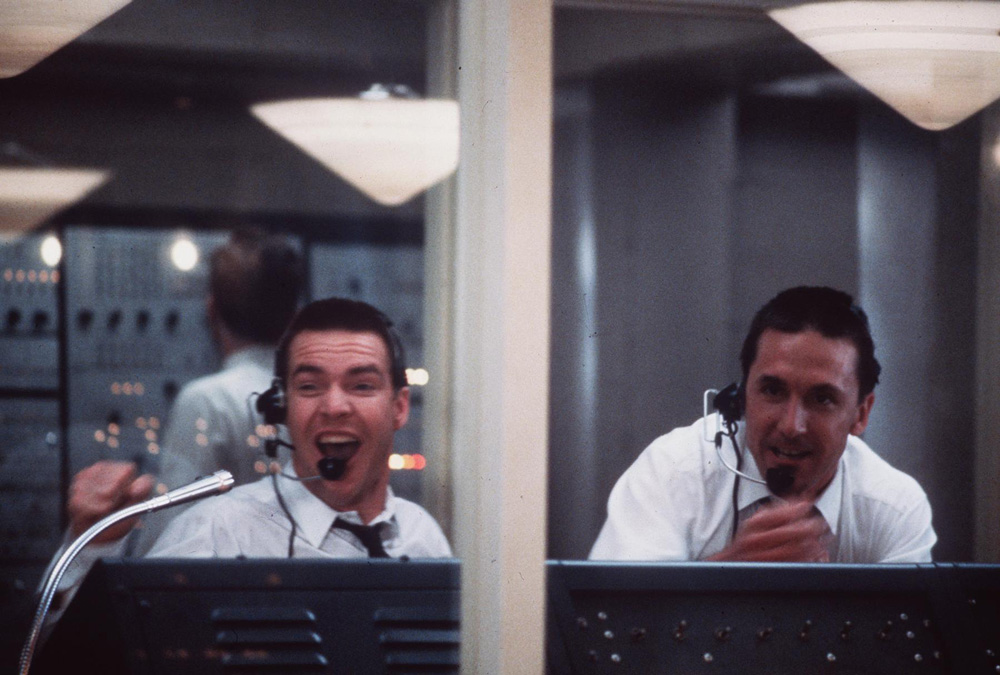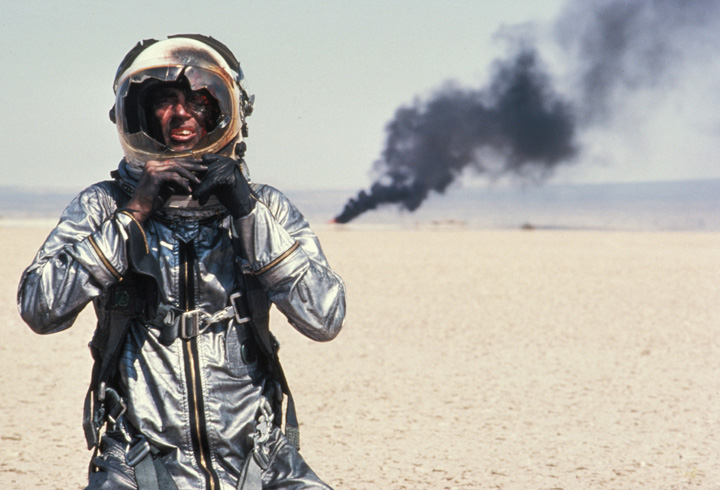
(c)1983 The Ladd Company. All.rights reserved.
What is Philip Kaufman's adaptation and directing technique of "The Right Stuff" based on historical facts?
2020.03.27
houston ceremony
The scene suddenly shifts to the Houston Coliseum in Texas. On July 4, 1962, a flashy ceremony was held here to invite everyone involved in Project Mercury to the newly established Manned Spacecraft Center (*25). It was Vice President Johnson, a locally elected official, who invited the facility to be built here.
Johnson, wearing a ten-gallon hat, proudly presides over the ceremony. 5,000 politicians and businessmen. Frank Sharp , a shady land developer who offers free housing. Roasted 30 cows. Flashy marching band and cheerleaders. The film also depicts chaotic situations such as Sally Rand's (Peggy Davis) fan dance.
This was not Kaufman's invention, but it seems that this was actually the case. He also uses Lando's dance scenes for longer than necessary, creating an atmosphere in which each astronaut couple becomes increasingly uncomfortable. After all, she was actually 58 years old at the time, so it must have been like watching a striptease show at a hot spring resort with her family.

"The Right Stuff" (c) 1983 The Ladd Company. All.rights reserved.
Cooper (*26), the only member of the Mercury Seven not yet in flight, is interviewed by reporters. The question was, "Who is the best pilot in the world?" Cooper is clearly thinking of Jaeger and begins to say, ``He's the one who owns The Right Stuff...'' but upon seeing Trudy's expression, he replies, ``He's right in front of me.''
*25 After 1973, the name was changed to Johnson Space Center.
*26 Actually, Schiller had not yet flown when this ceremony was held.
Jaeger aiming for space with NF-104A
The film contrasts the hustle and bustle of Houston with the quiet Edwards Air Force Base. On that wide runway, there is an NF-104A , which was developed by Lockheed for high-altitude zero-gravity training as part of the US Air Force Test Pilot School (USAF TPS) (*27) project. A special aircraft called (*28) had just been introduced. This model is a jet fighter F-104A with a rocket engine added, making it possible to control the aircraft even at high altitudes in thin air.
At the time, the U.S. Air Force was pursuing a manned space program (*29) independently of NASA, and USAF TPS was its training organization. Jaeger had been the school's principal since 1963. In the film, Crossfield looks at the NF-104A and says, "Unfortunately, this is the end of our development program. All future funding will go to Houston." Jaeger also believed that this aircraft would be able to break the highest altitude record by a single aircraft of 34,714 m, set by the Soviet Union on April 28, 1961, when a delta-winged Ye-66A (E-66A) was equipped with a rocket booster. , invites his partner Ridley (*30), who has been with him since the XS-1 days.

"The Right Stuff" (c) 1983 The Ladd Company. All.rights reserved.
Then, without following any formal procedures (*31), Jaeger boarded the NF-104A and broke through the tropopause to venture into the thin air of the stratosphere. However, the aircraft suddenly lost control and began to fall. He gives up control and escapes in an ejection seat, emerging from the Mojave Desert alive. (*32)
*27 USAF TPS was established in 1944 as a training institution for test pilots in the Army Air Forces. In 1962, its role expanded and the Air Force began training pilots for its own manned space program.
*28 The NF-104A is based on the F-104A, with a Rocketdyne AR2-3 rocket engine added between the exhaust nozzle and the vertical tail, and an RCS (Reaction Control System) that controls attitude by injecting hydrogen peroxide gas. ) were attached to the nose tip and both main wings, the tip of the shock cone (the conical structure at the center of the engine's air intake) was lengthened, and the wingspan was also extended by 61 cm. Unit 1 recorded an altitude of 120,800 feet (approximately 36.8 km) on December 6, 1963.
The actual aircraft that appears in the movie was a West German Air Force F-104G, with the wingtip fuel tanks removed and repainted. Also, the miniatures used in the special effects were based on commercially available models of the standard F-104, and did not depict the distinctive rocket engine. As a result, the result is a rather strange scene in which the plane uses a regular jet engine to reach altitudes close to space.
*29 At this point, the Air Force is stillManned spacecraft X-20 Diasona projectwas proceeding. The X-20 will be flown by graduates of the USAF TPS, andSpace Station MOL (Manned Orbital Laboratory)This is where the crew was supposed to come from. Coincidentally, however, the event was canceled on the same day that Jaeger had an accident with NF-104A. This was because the costs for the Vietnam War affected the space program budget, and the U.S. government had no choice but to abandon its policy of dual support between the Air Force (military use such as reconnaissance) and NASA (non-military scientific research). Ta. In the end, Jaeger's dream of going to space was not fulfilled.
*30 This is a theatrical lie; Ridley had been assigned to Japan as a member of the Military Assistance Advisor Group (MAAG) since 1956. On March 12, 1957, he died in a crash while flying a C-47 transport plane over Hakuba. He was the co-pilot at the time, and Jaeger said, ``If he had been in the cockpit, this disaster would not have happened.''
*31 This was also a theatrical lie; Jaeger officially attempted the highest altitude record with the third NF-104A, and on his second flight on December 10, 1963, he reached 104,000 feet ( Although it reached a distance of approximately 31.7 km), it crashed.
*32 In reality, the ejected seat became tangled in the parachute string, and fuel from the rocket that ejected the seat rained down on Jaeger's head. The helmet's faceplate shatters, and the pure oxygen flowing from the tank ignites the rubber inside, melting away the gloves. He suffered second- and third-degree burns to the left side of his face and neck and lost the tips of two fingers.
However, he miraculously recovered and returned to the USAF TPS, and the following year, on January 29, 1964, he conducted a test flight of the experimental M2-F1 aircraft. He also flew the B-57 strategic bomber more than 100 times during the Vietnam War. After retiring in 1975, he continued to fly as a consultant for the Air Force and NASA.

